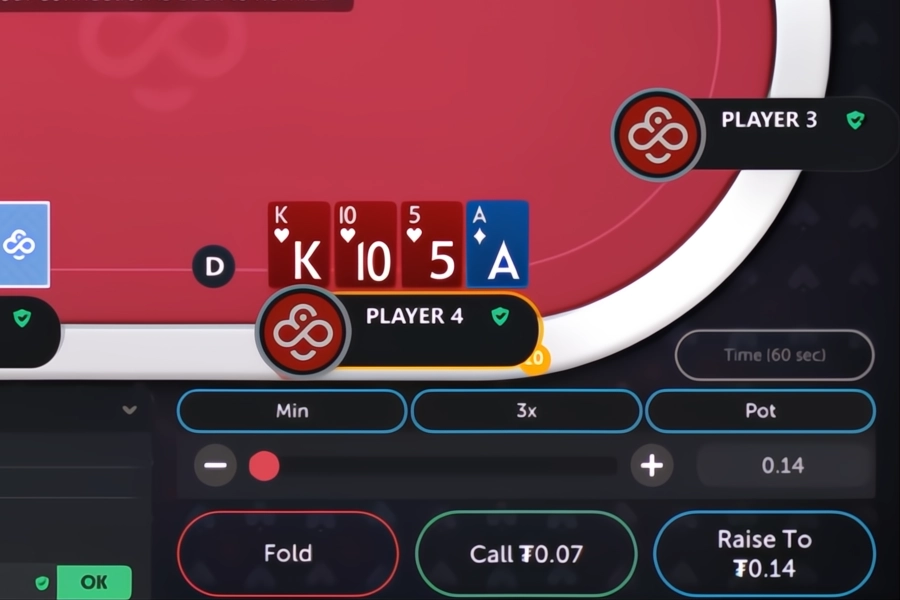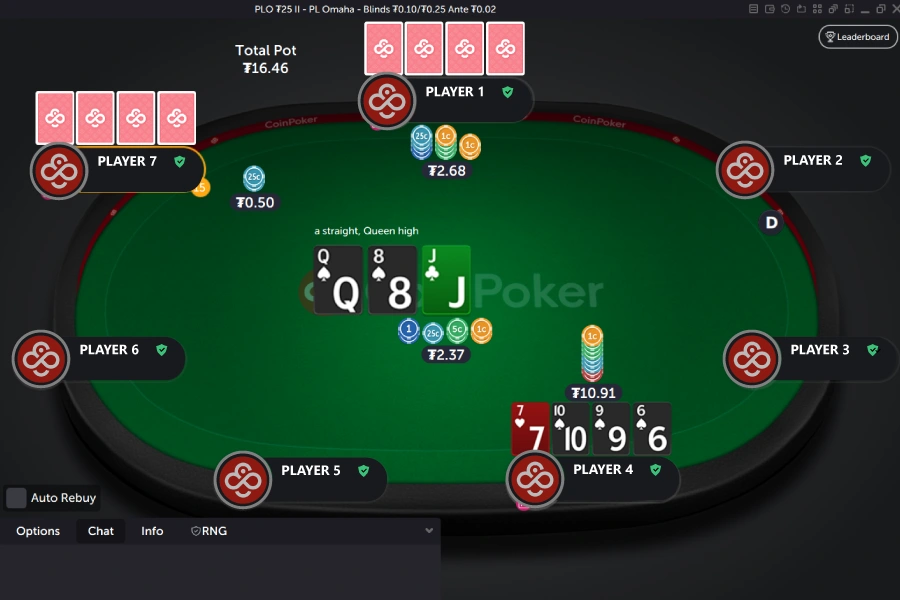Last Updated: 8 October 2025
PLO / Pot Limit Omaha Basic & Advanced Strategy Guide
Mastering PLO strategy is the best way to become profitable at Pot Limit Omaha poker. Learn basic & advanced PLO strategy with our guide today, and you’ll take the first step to winning real money online.
Strategy
Basic Pot-Limit Omaha Strategy: 6 Tips to Win More
If you are looking to start playing Pot Limit Omaha (PLO), here are a few tips that can serve as a foundation for your PLO strategy. These are six actionable tips that you can implement in your live or online poker game right now to boost your win rate and fix major leaks.

Don’t Apply Hold’em Hand Strength
If you are transitioning from NLH, you need to understand that the absolute value of hands goes down significantly in PLO. With four hole cards available to each player, making big hands becomes much easier in PLO.
Keep this in mind when you consider value betting with hands like two pair or bluffing with weak draws. Look for stronger hands to value bet, and choose draws with a large number of outs as your main bluffing candidates.

Be More Cautious About Bluffing
Bluffing is a big part of Pot Limit Omaha, but the best betting strategy differs significantly from Texas Hold’em. Instead of bluffing with “nothing” or weak draws, like you often do in Hold’em, you should look for hands that can make the nuts in PLO.
Starting hands in PLO can make a lot more big draws, giving you more natural bluffing opportunities. Forget about bluffing with air, and play your combo draws just as aggressively as you would a made hand.

Slow-Playing is Not As Effective in PLO
No Limit Texas Hold’em (NLH) players are used to slow playing their big hands, but this strategy doesn’t work very well in PLO. Every board-changing card can easily give your opponents a better hand, which makes it very important to protect your value hands.
Even on boards that don’t look too dangerous, you should usually put in your bets and raises as early as possible. This way, you will protect your equity and charge the big drawing hands at the same time.

Be Cautious on Paired or Flush Boards
Paired and flush draws can be particularly dangerous in PLO, since they open the door for your opponents to have very strong combinations. While players will mostly miss the board in NLH, the frequency of flushes and full houses in PLO is much higher.
Boards that bring a potential flush or full house on the flop are not ideal to start bluffing at. On the other hand, cards that change the board on the turn or river and bring in the flush or pair the board can be used as bluffing opportunities.

Adjust for Different Styles of Opponents
As you play PLO with different people, you will encounter a variety of strategies. Some players will play tight and wait to make the nuts, while others will play wild and bluff at every hand, looking to take down pots and abuse weakness.
As a PLO player, you must learn to adapt to the different playing styles of your opponents and adjust your strategy accordingly. Be willing to call down the maniacs wider, and bluff the nits even with weaker draws until they play back at you.

Adapt to Different PLO Stakes
Different PLO stakes bring a variety of challenges you must face. At lower stakes, players tend to play more cautiously, which can often make it hard to get paid. As you move up, the bluffing frequencies increase, forcing you to make many difficult decisions.
As you move up the stakes, remember that the strategies that worked at lower stakes may not work at higher stakes. Take your time to adapt to every player pool and build your strategy on the go, instead of sticking to the same old tricks.
PLO Starting Hands: What Hands to Play & Avoid Preflop?
Your PLO starting hand strategy sets the foundation for everything you do throughout the game. The best Pot Limit Omaha starting hands set you up for success and allow you to avoid the most frequent traps that could cost you a lot of money.

Here is a look at the best and worst starting hands you should keep an eye out for in PLO:
Which PLO Starting Hands to Play Preflop
The best PLO starting hands are the ones that can make top sets, top full houses, and nut flushes on many boards. As you would expect, having a pair of Aces is a great start, but not all AA hands are among the best starting hands in Omaha.
Some of the Best Starting Hands in PLO
Choosing the best starting hands in PLO is not as simple as in NLH. While in NLH you can follow a clear list of hands, PLO hands are defined based on several factors such as:
- High Pairs: Hands with high pocket pairs give you the potential to flop top set and make the top full house, potentially stacking smaller sets and full houses.
- Connectedness: Hands with connected cards are called rundowns in PLO. They have a lot of potential as they can often flop straights or straight draws.
- Suitedness: Hands with one or two suits, especially to a high card, are precious. Keep in mind that A-high flush draws are much more powerful than all other flush draws in PLO.
- High Cards: High cards in general, are always better than low cards. If you can make top two pair, you can often get value from a weaker two pair on the turn or river.
Here is a look at a detailed list of the best PLO hands based on the criteria we described above:
| PLO Starting Hand | Why It’s Good |
| A♣A♥K♣K♥ | Pair of Aces, pair of Kings, two A-high suits, connected high cards |
| A♠A♦J♠T♦ | Pair of Aces, two A-high suits, connected high cards |
| A♥A♠Q♥Q♠ | Pair of Aces, pair of Queens, two A-high suits, connected high cards |
| A♦A♣J♦J♣ | Pair of Aces, pair of Jacks, two A-high suits, connected high cards |
| A♥A♣T♥T♣ | Pair of Aces, pair of Tens, two A-high suits, connected high cards |
| A♠A♥9♠9♥ | Pair of Aces, pair of Nines, two A-high suits, high cards |
| A♦A♣X♦X♣ | Pair of Aces, two suits |
| J♠T♥9♠8♥ | Two suits, connected high cards |
| K♦K♣Q♦Q♣ | Pair of Kings, pair of Queens, two suits, connected high cards |
| K♥K♠J♥J♠ | Pair of Kings, pair of Jacks, two suits, connected high cards |
Which PLO Starting Hands to Avoid Preflop
The worst PLO starting hands all have one thing in common: it’s hard to see a world in which they make the best hand by the river. This includes four-of-a-kind, three-of-a-kind, and various disjointed sets of cards that don’t interact with each other.
A full list of the worst hands in PLO would be too long, but here is a look at a list of some PLO hands you should always avoid playing, no matter the situation:
Some of the Worst Starting Hands in PLO
Much like the best ones, the worst PLO starting hands also share many commonalities. The best way to recognize trash hands in PLO is by looking for the following elements:
- Small Pocket Pairs: The value of small pocket pairs in PLO is very low. Making a set of small cards will usually win you a small pot or lose you a big one, while the pairs on their own have practically no value.
- Low Cards: Hands with low cards are best avoided in PLO. These starting hands make an inferior hand by the river too often, making you pay off big bets on turns and rivers.
- Lack of Suits: Hands without a flush potential are quite bad in PLO. Without the ability to flop a hand like two pair and have a flush draw to rely on, your hand simply won’t have a lot of potential across the streets.
- Lack of Connectedness: Disconnected hands without the potential to make straights or straight draws can be very difficult to play and call bets with, unless you flop the nuts.
Here is a list of some of the worst hands you can get dealt in PLO, based on the criteria we described:
| PLO Starting Hand | Why It’s Bad |
| 2♠2♥2♣2♦ | Four cards of the same rank, no potential to improve |
| 7♦2♠2♥2♣ | Three cards of the same rank, no flush draws, no connectedness, low cards |
| T♠6♦3♣2♥ | Four disjointed cards, no flush draws, minimal connectedness, low cards |
| Q♠7♥5♦2♣ | Four disjointed cards, no flush draws, minimal connectedness, low cards |
| Q♥7♥5♥2♥ | Four disjointed cards, four cards of the same suit, minimal connectedness, low cards |
| K♥9♠7♦3♣ | Four disjointed cards, no flush draws, minimal connectedness, mid-to-low cards |
| J♣4♥4♠2♦ | Small pocket pair, no flush draws, minimal connectedness, low cards |
| 4♥4♣2♦2♠ | Two small pocket pairs, no flush draw, low connectedness, low cards |
6 Advanced Pot-Limit Omaha Strategies: Level-Up Your Game
As you move up the stakes, you will need more than just the basics to win.
These advanced PLO strategy tips will take your game to the next level and let you win against stronger opponents. Keep them in mind and build up your PLO strategy around them.

1. Always Consider Your Blockers in PLO
Blockers are a big part of any successful PLO strategy. They allow you to bluff in the right spots, make the right hero calls, and fold a losing hand. Whenever you play a PLO hand, don’t just focus on the cards that make up your hand, but your hand as a whole.
For example, on all flush boards, consider bluffing if you hold the Ace in the appropriate suit, making it impossible for your opponent to have the nuts. Similarly, you can bluff or bluff catch with blockers to the nut straight.
2. Know the Odds of Double-Suited Hands
Double-suited hands are incredibly powerful in PLO, as they allow you to flop many draws and play your hand aggressively after the flop. Any double-suited hand will flop a flush draw more than 20% of the time, with other factors like connectivity building more opportunities.
Keep in mind that hands suited to an Ace are much more powerful than any other suited hands. Double-suited hands with low cards are a recipe for disaster, as they often result in the low end of a straight or a poor flush in large pots.
3. Calculate Straight Draws Carefully
Straight draws are a massive part of Pot Limit Omaha, as they are the most common draws in the game. Anytime you have a straight draw, you should carefully count the number of outs at your disposal and consider the equity they give you in the hand.
When considering your straight draw odds, also remember that some straights can be trouble. All straight cards that give you a straight that’s not the nuts can be problematic, as they potentially make your opponent the nuts.
4. Learn Value-Betting Not-Nutted Hands
While value-betting the nuts is very important in PLO, the best players also know when to bet for value with their non-nutted hands. This can include betting your set even when a straight got there, or your weaker flushes.
Value-betting without the nuts is essential for two reasons. First, you get to charge your opponents to draw even when you don’t have the nuts. Second, you make yourself more unpredictable and make it harder for other players to know what you have.
5. Know When to Lead the Flop
While NLH players are used to checking to the preflop raiser, the best PLO players often take the initiative on the flop. The so-called “donk bet” is much more effective in PLO, as c-bet frequencies are much lower.
Instead of simply checking when you flop trips or a strong draw, you may consider leading from out of position. This puts your opponents in a difficult spot and denies any equity they may realize by checking back the flop and seeing a free card.
6. Deny Equity Like a Pro
The draw-heavy nature of the game makes it essential to deny equity whenever you can in PLO. This means betting big when you have made hands, even when the board doesn’t seem that draw-heavy.
If you are tempted to bet small after a brick hits the turn, think again! PLO solvers and the best PLO players all agree that betting big on the turn to deny equity is the best way to maximize your win rate in this game.
Strategy Tips for PLO Cash Games
If you are looking to build a strong PLO cash game strategy, here are a few tips to keep in mind and consider when playing in a cash game setting:
- Position is Everything: When playing PLO with deep stacks, position is key to success. Play significantly more hands on the button, and look for any reasons to fold when out of position.
- Play Suited and Connected Hands: Suited and connected hands that can make big draws should be your bread and butter. Avoid playing unsuited hands and hands that have little potential to make a straight.
- Fold Small Pocket Pairs: Small pocket pairs are trash in PLO. Making a set is hard, and when you do with a small pocket pair, you will often lose to a bigger set or full house by the river.
- Control the Pot with Marginal Hands: Hands such as weak flushes or bottom straights should be played with great care. You may have the best hand, but you won’t get paid if you start betting big.
- Maintain a Healthy Bankroll: The variance in PLO cash games is massive. Keep this in mind and maintain a healthy poker bankroll of 100 buy-ins or more at all times.
Strategy Tips for PLO Tournaments (MTTs)
Now that we have covered some cash game tips, let’s discuss PLO tournament strategy. These tips will help you cash more often and reach more final tables in your PLO tournaments:
- Survival is Key Early: Building a massive stack early should not be your goal in PLO MTTs. Instead, make survival your main goal, and look for spots where you can win big pots with the nuts.
- Tighter Up Your Ranges at Shallow Stacks: As the tournament progresses, the average stack will get shallower. Tighten up your range and value high cards more than you did in the early stages.
- Play Aggressively in Top-Heavy Structures: If the tournament payout structure is top-heavy, look to build up a stack and aim for those top positions.
- Apply ICM Pressure at the Right Time: As you approach the money and the final table, apply ICM pressure on the shorter stacks and put their tournament life at risk.
- Controlled Aggression Wins Final Tables: You won’t win a PLO tournament by waiting for the nuts. At the final table, remember to play aggressively and apply pressure in the right spots to deny your opponents from making their hands.
The 3 Most Common Strategy Mistakes PLO Players Make
If you watch people play this game, you will see the same PLO strategy mistakes happen time and time again.

These are the three most common PLO strategy mistakes you should avoid in your game to ensure you are not the fish at the table:
1. Playing Too Loose
Playing too many hands is a sure way to lose any edge you may have in a PLO game. There is no justification for playing random starting hands and getting involved with small pairs or offsuit rundowns. Throw away the trash and wait for good starting hands to get involved, or you will be a guaranteed loser regardless of how you play postflop.
2. Bluffing Too Much
There are many times when bluffing is right in PLO, but that doesn’t mean you should mindlessly barrel every board. Avoid bluffing without a good number of outs to the nuts, and make sure you know what you are trying to fold out. Never bluff if your hand has no connection with the board at all.
3. Overvaluing Pocket Aces
Pocket Aces are a strong starting hand in PLO, but not nearly as strong as they are in NLH. Without any connection to the board, AA becomes just another pair in a deep-stacked PLO game. Avoid playing Aces for all your chips if the board does not cooperate, but be willing to play for it all preflop.
It’s Time to Practice Your PLO Strategy in Real Money Games
It’s time to put your newly found PLO strategy knowledge to the test in real money poker games. Only practice can make perfect, which is why only playing PLO will make you a master.
Join CoinPoker today to access hundreds of tables, practice your PLO strategy in real time, and watch your win rate soar with every new adjustment you make.
Related Articles
FAQs
The best starting hand in PLO is AAKK double-suited. However, any double-suited Aces are also exceptionally valuable.
Position is a foundational element of a good PLO strategy. Play more hands in position, and you will immediately notice an improvement in your results.
Blockers are cards that prevent your opponent from having certain hands. For example, if you hold the Ace of Spades, your opponent can’t possibly have the nut flush in Spades.
You should bluff relatively often, but always with equity. Avoid bluffing with hands that have no reasonable chance of improving.
You should avoid hands that have no suitedness or connectivity, as well as small pocket pairs and hands made up entirely of small cards.
Explore More
Announcements
Read recent announcements from CoinPoker about new games, ambassadors, and changes to our platform.
8 PostsGuides
The go-to resource for mastering poker with expert tips and strategies. Whether you're a beginner or a pro, our guides will elevate your skill level.
60 PostsNews
Find the latest poker news from CoinPoker, plus our latest CoinPoker Weekly and Monthly Newsletters. Updates about games, promotions and other exciting crypto news.
88 PostsPromotions
Find the latest coinpoker promotions here. Explore the crypto poker world with the best poker promotions available.
1 Post
















